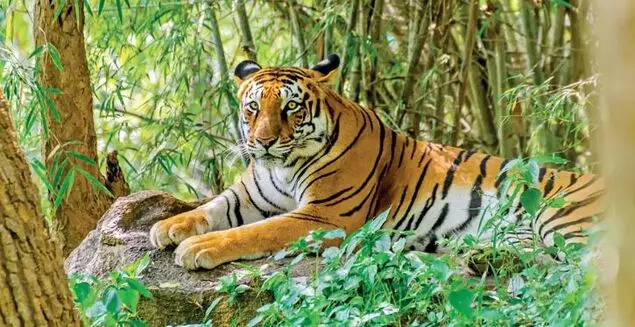
‘From being hunted to protected, the tiger symbolises India’s awakening’ | India News
[ad_1]
The tiger is iconic to India. A very large carnivore, at a time, hunting it was seen as a symbol of great courage, particularly for kings. In the fourth century, Emperor Samudragupta fought a tiger — a coin thus titled him ‘the conqueror of tigers’. However, in northern and central India, the lion hunt was more prominent — this changed with the arrival of the British.
The first British bridgehead was in Bengal where tigers abounded. In the late 18th century, the young son of a British general, Hector Munro, was carried off by a tiger in Sagar Island. This incident was replayed often in English history, with famous ceramic makers, for instance, featuring a grisly image of a massive tiger mauling the hapless British soldier. After 1850, the British dislike of tigers also became linked to the advance of cultivation and the fact that tigers preyed on domestic cattle too. As draught power came from cows and buffalos, the tiger was seen as halting the growth of profitable agriculture.

A WALK THROUGH TIME: The tiger has represented many ideas in India, from freedom which had to be conquered to nature which needed to be cherished. Photo courtesy: iStock
The Victorians of the late 19th century also had a very literal idea of hierarchy on Earth, with man seen as the pinnacle of creation and European man, its apogee — but here was this animal attacking them. So, the tiger hunt asserted both manly superiority and imperial dominance. Lord Curzon embodied this Britain — there are pictures of him with a Maharaja, five tigers lying around them, all shot before breakfast. The tiger hunt also became a means by which Indian princes, who ruled about a third of British India, forged links with the colonisers.

THEY MAKE A FOREST: Protecting tigers means saving entire ecosystems, including the endangered golden langur which helps forests flourish through functions like seed dispersal. Photo courtesy: iStock
Thus, the tiger became a metonym, a symbol of freedom which had to be vanquished — this was also true of the tiger in lands colonised by the Dutch in Java, the French in Indo China and much of tropical Asia. Independent India changed this. In the 1960s, India experienced monsoon failures, drought, severe food shortages and the need to import grain. Against this backdrop, concerns about forests, healthy soils and wildlife grew. This was not without challenges. At the time, the sport safari lobby was strong and tigers were seen as a way to earn foreign exchange — if a tiger was shot by a foreigner hosted by a safari company, India could apparently earn forty thousand rupees. Yet, by the 1970s, India’s leadership was ready to make a change.
The insights of a new generation of environmentalists were taken on board. In 1971, Kailash Sankhala, director of the Delhi Zoo, wrote a very influential study on the state of the Indian tiger. The Bombay Natural History Society also did an extremely important survey while the IUCN General Assembly declared the Bengal tiger in danger, placing it on its Red List. As people understood its value, the tiger began to evoke a sense that India’s natural history was as important as our monuments and cultural symbols.

WHY YOU WERE HUNTED: The Royal Bengal tiger, whose numbers, according to some estimates, declined by over 90% through the last century, posed both a threat and an ideological challenge to the worldview of the British Raj in India. Photo courtesy: iStock
By the early 1970s, tiger hunting was banned. Leopard and tiger skin exports were stopped and by 1972, the Wildlife Protection Act brought the tiger and other animals under its ambit. Interestingly, a major conservation effort ‘Project Tiger’ was launched in 1973 just before the celebrated Hindi film ‘Zanjeer’ where the bad guys ask Sher Khan, played by Pran, to attack Inspector Vijay, played by Amitabh Bachchan. Pran replies, ‘Like me, Vijay is also a tiger — I will not attack him as I’ve heard there are very few tigers left in our country and the government has banned tiger hunting’. So, an awareness began to emerge in popular culture as well while the state governments which created the first Indian tiger reserves gave up a great deal of revenue to protect core habitat from commercial activity.
Alongside, Sankhala, director of Project Tiger, argued that tigers symbolised environmental quality — having tigers in a forest meant there were deer, boars, fowl and vegetation too. The first nine tiger reserves became a home to several species — Manas in Assam, for instance, houses many endangered species like the hispid hare and the golden langur. Increasingly, the tiger symbolised the idea that India is not only about its human states, faiths and languages — it is also about all the other creatures who inhabit this land, including over 500 kinds of mammals, 1,100 kinds of birds and 1,000-plus species of butterflies.
The tiger came to represent a new sense of fragility around these species and nature itself. India faces new conservation challenges now. Earlier, it confronted clashes over biomass, like poachers targeting tiger skins or rhino horns. But we now face conflicts over mineral wealth under forest lands. India must also balance its development needs with protecting wildlife habitat. We need new land use planning which considers the security of all life forms with ecosystems, the water cycle and productive land — we need to envision a new fabric of living landscapes. Extractive projects like mining should be planned with minimal impacts on tigers and all the life — including ours — these wondrous beings represent.


[ad_2]
Source link


